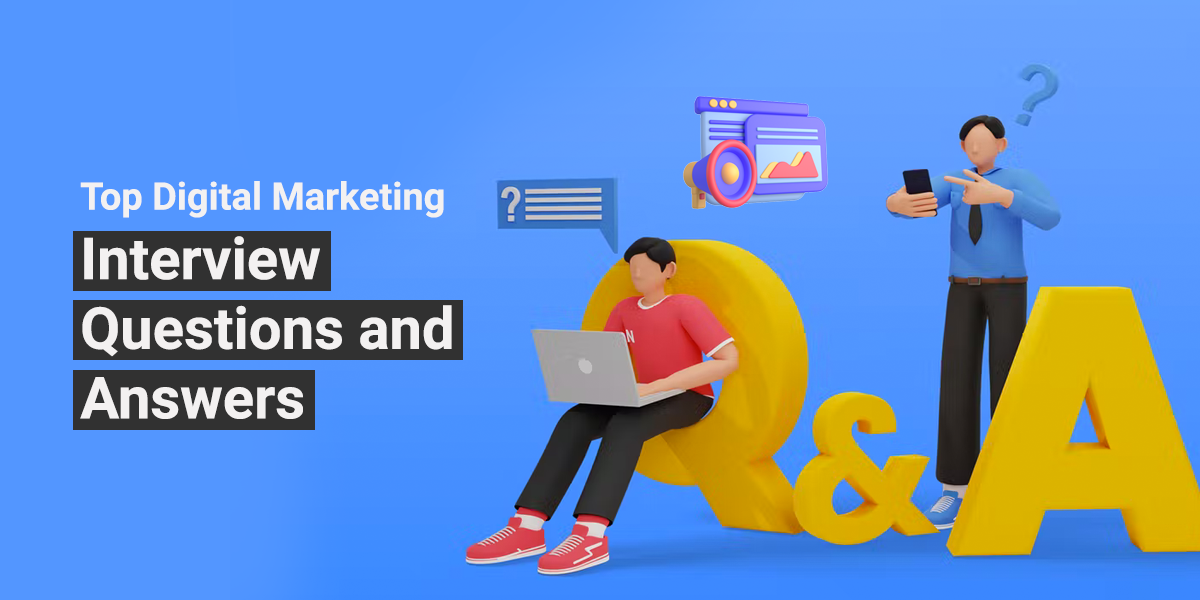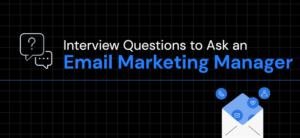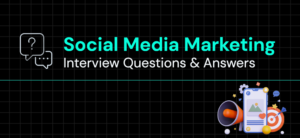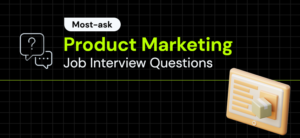Most Asked Digital Marketing Interview Questions & Answers- Updated [2023]
Published On
July 5, 2022
The Digital Marketing world is dynamic and ever-changing —technology, trends, and tactics are never stagnant.
Are you looking to build your career in Digital marketing Filed? And if you are in this field then how can you be sure you’re keeping up with the times?
So, there is only one way to remain relevant and keep up with the latest digital marketing trends to keep an eye on marketing trends and statistics. Whether you’re focused on Search Engine Optimization (SEO), content marketing, video marketing, social media marketing, email marketing, lead generation, Media advertising, or marketing technology, we’ve collected a plethora of questions that will help you to crack any Digital Marketing job interview with ease.
If you are Preparing for a Digital Marketing Job interview then this exclusive list of the most asked real-world Digital Marketing interview questions and answers help you ace the interview in 2022.

This is the very basic question asked to freshers or interns. The full form of SEO is Search Engine Optimization and it’s a process used to optimize a website’s (On-page, Off-Page, technical configuration, content relevance, and link popularity so its pages can become easily findable (Easy to Rank on SERP), more relevant and popular towards user search queries, and as a consequence, search engines rank them better.
I’m not sure do you know the answer to this question but practically you have performed this activity every day.
So, let’s understand here how.
The words which are used to search for something on search engines (Google/YouTube) are called keywords. For example, if a consumer types “Best Digital Marketing Agency” in the Google search box, then here the keyword or key phrase is “Best Digital Marketing Agency”. Now I think you got an idea about what the keyword is.
About the importance of Keywords from the SEO perspective, are the building blocks for your SEO and a very important On-Page SEO factor.
Optimizing keywords for any queries can be challenging. If you’re new to SEO, the process may still feel a bit nebulous.
Following are the key areas where keywords can be used to optimize your website for better ranking –
This is the most popular question asked in almost every Digital Marketing interview question. To help you with the right answer to this question follow these top proven and high-impact tactics for driving more traffic to your online store.
To help you get the answer to this question, we have listed some statistically proven tactics that you can use to steadily increase your website conversion rate and improve your top line.
Again, this question has its own fanbase, which Means many people broadly know the answer of this question and the answer is:
The main difference between SEO and SEM is that SEO is an unpaid strategy, while SEM is a paid strategy. Check this blog to know more about What is SEO?
Every single day digital marketing is evolving. Each moment there are multiple new trends or technology is getting introduced and as a marketer, we are supposed to be the parts of that change to keep and become successful digital marketers.
To stay updated, you can track the sources given below and never miss out on anything:
Today, there are thousands of options when evaluating software for your marketing need. And most successful marketers rely not just on one tool, but a suite of digital marketing tools to grow.
Visit one of my posts to check all the important online marketing tools I have used so far are listed here.
There is no question that an effective SEO strategy is composed of both on-page and off-page components. But is On-page and Off-page Seo. Let’s understand here.
There are multiple ways to redirect a webpage or an entire website, the two main ways being either a 301 or 302 HTTP response code.

Pay-per-click (PPC) marketing is a paid media marketing channel that allows you to run the ads and give you the opportunity to grow your business by showing the ads to the people who are actually looking for your product or services. But without a smart strategy and careful tactics, pay-per-click can cause major headaches.
If you’re ready to develop a more advanced Pay per click PPC campaign strategy for your business, these 5 steps can help you get a head start.
Note: PPC strategy/campaign optimization is an ongoing process.
Google Ad extensions let you show more real estate on the SERP, like providing more related links to your site, special discounts and offers, and other information that can draw people in and increase your click-through rates (CTRs).
Check some of the AdWords ad extensions here:
This is a feature through which you can display ads or change bids during certain times (best time as per the data shows). You can create a maximum of 6 ad schedules per day for each campaign in your account. For more detail check this google guide.
The ad formats available to you depend on your campaign type and what type you are willing to select accordingly there will be an option.
Learn more about the different campaign types available.
Remarketing Lists for Search Ads (RLSA) is an advanced and smart targeting option available inside the Google ads platform. It allows the audience signals –data that Google uses to identify user intent for an audience–to help target and deliver specific remarketing ads without the flaws of traditional remarketing.
Keywords are the most important tools in a digital marketer’s toolkit.
Yes, you can make or break your campaigns by adding different types of keywords in your campaign. Keywords are the backbone of what drives clicks and find the people that convert, they are what brings your ad to the front of their search.
Check these are the 5 keywords, matching options are,
There are lots of reasons the social media giant rejects ads which are fairly obvious, but sometimes your ad gets rejected, and you have no idea why. Don’t despair!
Google Ads automated bidding, Smart Bidding, manual bidding — the number of available bidding options available seems to keep growing, and understanding how each one works can be confusing.
Still, there are four major effective Bidding strategies you should know:
There are seven different automated bid strategies:
1. Maximize clicks
2. Target search page location
3. Target outranking share
4. Target cost-per-acquisition (CPA)
5. Enhanced cost-per-click (ECPC)
6. Target return on ad spend (ROAS)
7. Maximize conversions
Google’s automated bidding presents a fantastic opportunity to save time spent on manually setting bids while optimizing for more conversions, clicks, or whatever your desired goal may be.
Invalid or fake clicks, unintentional and malicious software clicks all are the same. Google has an advanced algorithm and mechanism to automatically detect and filter invalid clicks from the user account.

There are a ton of reasons why Marketers choose email as their 1st choice. It’s still one of the most effective and reliable methods to boost ROI. As per the status, 87% of B2B & 79% of B2C marketers still rely on email to spread their new product launch or any articles or blog posts.
Through email marketing, you personalize content for each individual, and that results in better response rates. The more personal your marketing message will be the more chances are for the outcomes.
The main challenge of email marketing is to not email deliverability, or email open rates. And at the same time not getting people to take action and click on your email campaigns once they’ve opened and read the email content.
Use the below formula to calculate the email click-through rate.

When an email bounces in general, it means it can’t be delivered to an inbox. “Hard” and “soft” designate the two groupings of failures: one’s more permanent, and one’s less permanent.
A hard bounce means there are permanent reasons why the email wasn’t delivered. For that, there can be multiple reasons why your email wasn’t sent. The reason can be anything, maybe the email isn’t correct, the email domain isn’t a real domain, or perhaps the email recipient’s server won’t accept emails.
A soft bounce means there was a temporary issue affecting the email’s delivery.
For this also there can be any reasons, there might be chances that the email file you have attached might be too large, that can be one reason
Pro Tips: As better practices try to keep your total bounce rate under 2% — much higher than that, and you’ll start noticing some deliverability issues.
Taking the time to craft a personalized message to your customer may help you stand out from the competition and build lasting connections with customers.
Here are some points by following them you even can better be connected with your audience/customer.
If you are looking for a new job in email marketing and you’re trying to learn email marketing terms then I’m sure it can sometimes feel like a new language, and it’s normal to feel lost for sure.
To help you get up to speed, here we have added a quick glossary of email marketing terms that you should know. Let’s get to it.
This is a complete experiment. If you want your emails to have a big impact, you need to send them when most people check their inboxes. The right timing can largely affect your campaign’s open and click-through rates.
For the answer to this question, I will leave it to you. You can check this infographic to get an understanding of even better of the best time to shoot your mail.
The best part of email marketing is that it’s a very cost-effective way of promoting your services/product. By email marketing, you can be fast, flexible, and cost-effective when it comes to reaching new customers and retaining existing customers by encouraging repeat website visits.
The benefits of email marketing include:
Disadvantages of email marketing
There are many types of email marketing available and it is your choice what email campaign your organization should be implementing because every business is different so tailor your strategy accordingly.
Here are some of the Email Marketing Campaigns I have mentioned below.
If you are already doing email marketing then I’m sure you’ve run into the frustrating question “why are my emails going to spam?” if you are new then in that case you must know how to stop your emails from going to spam.
A successful email starts with a subject line that grabs the attention of your recipients.
Here are a few proven strategies you should try out.

Social media marketing is important for many reasons almost for all businesses and individuals- as it allows you to reach, nurture, and engage with your target audience — no matter their location. Businesses are using social media to connect and promote their product and services to a wider audience and are able to generate brand awareness, leads, sales, and revenue.
There are a ton of benefits to using social media marketing. It should be an essential piece of your business marketing strategy.
Learn more about how social media can help your business with some social media benefits!
This question is about sharing the experience, but here are the tips you can always follow to be more effective.
Always focus on some good insightful posts instead of low-quality posts (that don’t add any value to your audience). A good and quality Social Media post should be part of your social media strategy to give good thought to and have a reason for every post.
There is no single business that doesn’t makes mistakes on some issue or the other. So, for that, you can use these tools to help you to manage negative reviews effectively.
The easiest way to create a cohesive social media strategy is by developing a social media calendar.
There are multiple ways you can like, and track your website’s total traffic from social media sites. Determine what percentage of total leads come from social media, and break this data down for each social media page. Also, you track and compare how many leads you get per follower on your various pages to determine where you’re being the most effective.
Today, many excellent social media tools are allowing you to accomplish almost every task as a social media marketer.
There are a ton of tools out there to help you quickly and efficiently assess how you stack up against your top competitors.
Some of the tools we use:
Here is the list of best social media tools to help you identify gaps in your own strategy—and stay one step ahead of everyone else.

Good content connects with your new as well as existing audience and seamlessly flows towards your offering. Good content always helps you position your brand as a thought leader in your industry.
Here are some of the key elements of good content.
A Content calendar helps the team (which is a mix of creative roles from writers to editors to strategists to designers) to formalize the process of creating and publishing content by giving you a structured schedule to work with.
There are multiple ways we promote the content once it goes live. We promote our content via both paid and organic channels, which include pay-per-click advertising, influencer outreach, PR, social media, email marketing, and syndication.
We used to measure your marketing goals in a concrete way and allow you to identify your success factors. Here are some suggested KPIs for marketing content:
These are the primary purposes we follow while creating the content.
Content Planning and Strategy: Under this process, everything moves around developing an overarching plan and strategy for your content.

Creating iconic marketing campaigns today might mean going viral, but the basic elements of good marketing haven’t changed as much as you might think.
There are many campaigns that I personally liked which some of them are:
In 2021, Android held a share of 95.84 percent of the mobile operating system market in India. This was followed by Apple’s iOS, a distant second, with a 3.1 percent market share. Android went from just above 10 percent in 2012 to more than 60 percent within four years.

There are many but some of my favorite which I followed them is Microsoft Zune, Amazon Fire Phone, and Crystal Pepsi.
I’m sure you must not have heard the anime of these brands because they could not make an impact on consumers’ minds. And one and only reason for their failure was poor marketing.
Definitely, Apple, Because I like innovation and beauty every time they come up with, and about Apple, as a brand, I like the most to dream big and inspire other’s themes.
In my view, the brand of Apple personifies these values, and it is one of the main reasons why I am a big fan of their products.
It was not an easy pick for the best marketing campaigns so far. Because it’s every time one and another brand are coming up with brilliant ideas and promotions.
With an increasing number of emerging channels and technologies in the hands of marketers, today’s campaigns are, in their vast majority, extremely innovative and impactful.
The best part of successful ad campaigns has the power to stir up emotions and stay in our minds for a long time (Bisleri Ads), influencing our buying decisions, directly or indirectly. So, you must always keep an eye on them!
All marketers face a range of challenges. And, ever since 2022, the ways we’ve had to pivot, adjust campaigns, and address challenges have been unlike anything many of us have had to do before.
Marketing as a function has more responsibility than ever – to guide a business towards growth in the face of uncertain times. And below are some of the areas in which I feel marketers are lacking in terms of depth of knowledge and expertise.
1) Demonstrating marketing’s value
2) Lack of fundamental marketing knowledge
3) Understanding customer behavior
4) Making digital strategic
5) Creating growth on a budget

Get In Touch With Our Team And Experience A Smarter Approach To Digital Marketing.